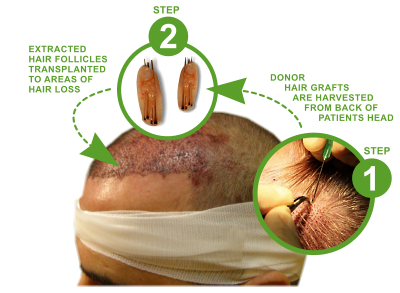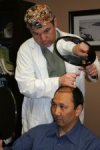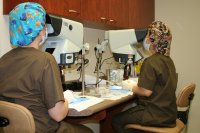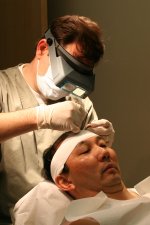 The Basics
The Basics
Hair transplantation is a surgical procedure that moves donor hair follicles, which will usually last a lifetime, to an area of noticeable hair loss that we call the recipient area.
Hair transplantation is a surgical procedure that moves donor hair follicles, which will usually last a lifetime, to an area of noticeable hair loss that we call the recipient area. Donor hair follicles are usually removed from the back and sides of your head (or rarely from other parts of the body.)
At the CHTC we excel at both the art and science of hair transplantation. The art is to move the follicles to create a perfectly natural look and to gain the most cosmetic benefit from each graft that is transplanted. The science is to ensure the maximum survival of the transplanted grafts and the minimum disruption of the donor area.
 Planning Your Hair Transplant
Planning Your Hair Transplant
Things that we consider in planning and designing your hair transplant include:
- Your current pattern and degree of loss.
- Your potential for future loss based on current signs, your age, and your family history.
 Your hair density and hair qualities.
Your hair density and hair qualities.- How important certain areas are to you, and how dense you need the hair to be in those areas.
- The shape of your face and head (to determine the level and shape of your new hairline).
- How you will look when you get older.
- Your natural hair direction.
- Your hair styling preferences.
We also have to figure out how many procedures you may wish to have (and how many you can afford) in your lifetime.
For more details about planning for men, click here to download a PDF file.
For more details about planning for women, click here to download a PDF file.
Our Techniques
 At the Canadian Hair Transplant Centre, we believe that Follicular Unit Hair Transplantation (FUT) gives the best and most natural results for most patients.
At the Canadian Hair Transplant Centre, we believe that Follicular Unit Hair Transplantation (FUT) gives the best and most natural results for most patients.
Follicular units are natural bundles of 1 to 3 or more hair follicles. We are consistently meticulous about our technique so that you can get the best possible results.

There are two ways to get follicular units for transplantation: FUT (Follicular Unit Transplantation, or ‘strip harvesting’) and FUE (Follicular Unit Extraction).
FUT is reliable, efficient, and less expensive than FUE. FUE may have certain advantages in specific situations and is the recognized gold standard method. After you are completely numb, a narrow, long, shallow strip of skin is removed from your donor area. The resulting gap is closed by suturing the skin edges together.
A narrow 1-2 mm scar will result but it can be easily hidden-even by short hair. The harvested strip is then dissected into follicular unit grafts using microscopes to aid in visualization. Microscopic visualization is essential to ensure that follicles are not damaged, and that ideal grafts are prepared to ensure excellent survival. Tiny holes are made in the numb recipient area, then the grafts are placed into the holes. No visible scarring will be seen in the recipient area and, after the hair grows, you will have natural-looking hair.
FUE is a newer method that involves removing individual follicular units from the donor area and leaving the tiny holes to close and heal by themselves. If you have very short hair, the tiny resulting scars will be less noticeable than the long, narrow scar from FUT. The follicular unit grafts will be checked and trimmed under microscopic visualization before being placed into tiny holes in the recipient area.
We may perform other techniques for a few patients for specific reasons.
For more details about techniques, click here to download a PDF file.
Concerns
Risks
Hair transplantation is inherently a very safe procedure. Although it can take a long time to perform, it is still minor skin surgery. People often ask about the risks of infection and bleeding but these risks are very low. We typically use sedatives, painkillers, and local anaesthetics, but we are very careful with medications, and we monitor you closely to ensure your safety Read More…
What to Expect
 Day of Surgery
Day of Surgery
Staff at work Your hair transplant day will likely be much easier than you expect.
After you arrive, we will answer all your questions, take several photographs, and get you all set. Dr. Simmons will then review the entire plan with you before starting your hair transplant. Read More…
Instructions
Download the PDF: Hair Transplant Instructions.


